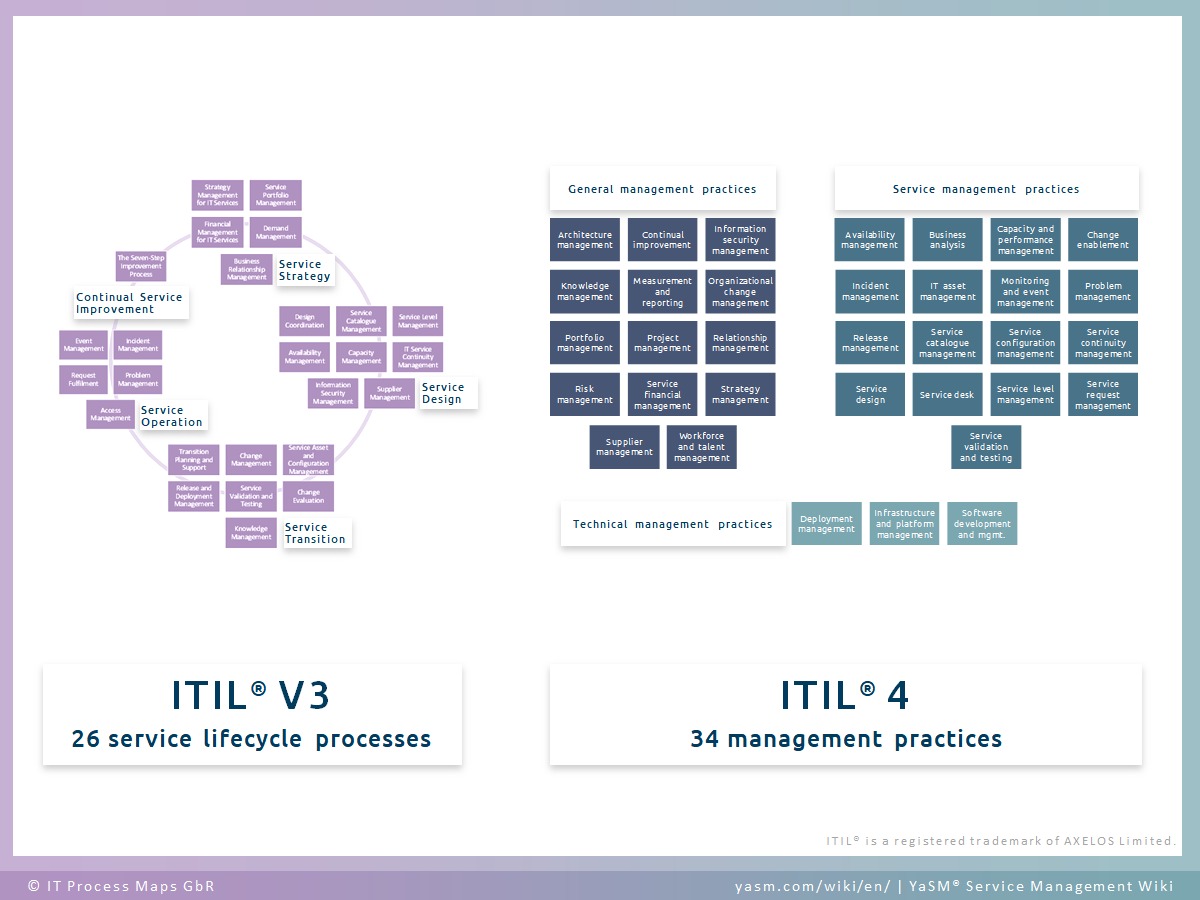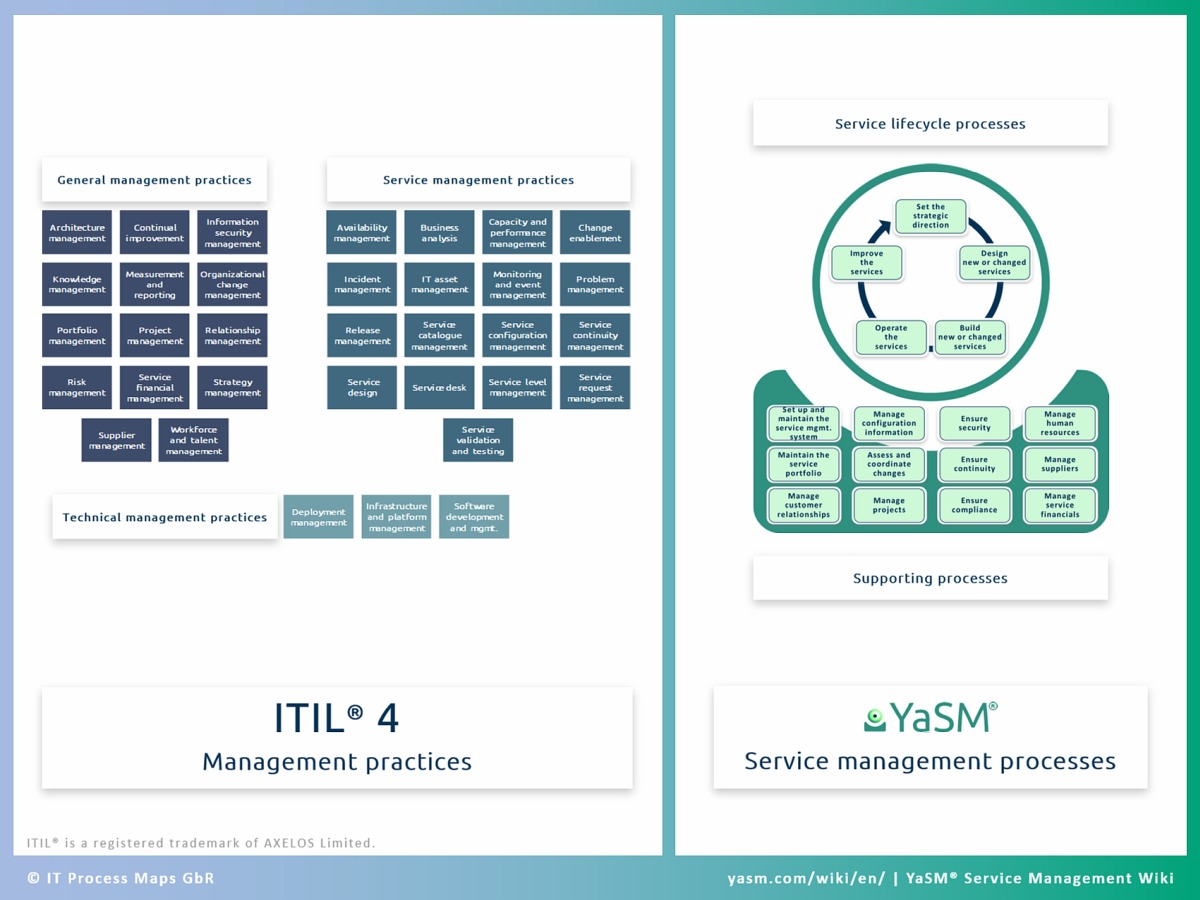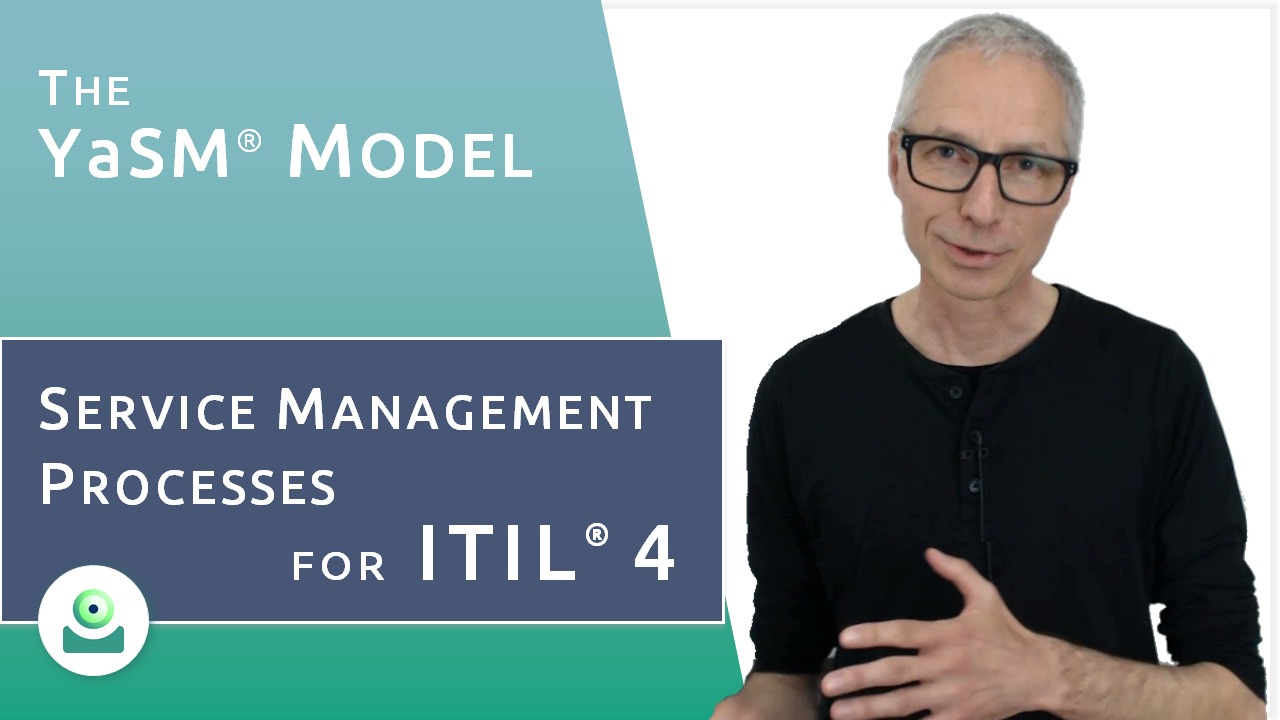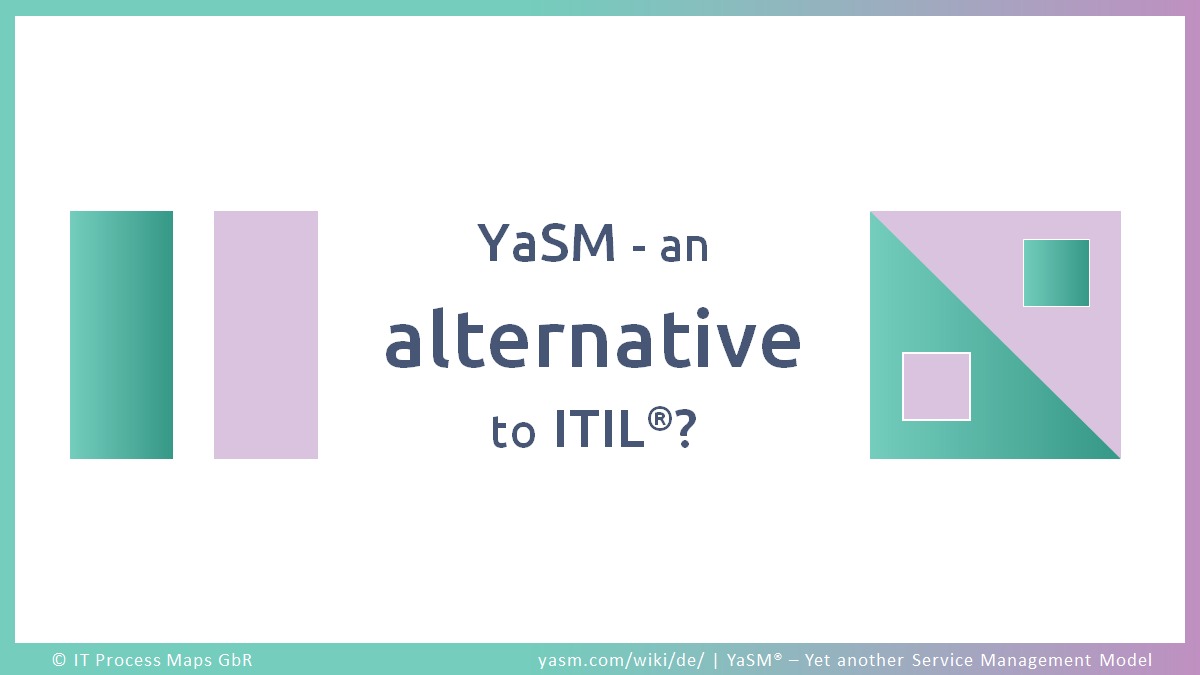YaSM and ITIL: Difference between revisions
No edit summary |
No edit summary |
||
| Line 16: | Line 16: | ||
<meta name="twitter:site" content="@yasmcom"> | <meta name="twitter:site" content="@yasmcom"> | ||
<meta name="twitter:creator" content="@yasmcom"> | <meta name="twitter:creator" content="@yasmcom"> | ||
<meta name="twitter:title" content="YaSM and ITIL® | <meta name="twitter:title" content="YaSM and ITIL®"> | ||
<meta name="twitter:description" content="Can a service management process model like YaSM define ITIL® 4 processes, and is it possible to provide ITIL 4 process templates?"> | <meta name="twitter:description" content="Can a service management process model like YaSM define ITIL® 4 processes, and is it possible to provide ITIL 4 process templates?"> | ||
<meta name="twitter:image" content="https://yasm.com/wiki/en/img/yasm-frameworks/itil/16x9/itil-4-processes-yasm.jpg"> | <meta name="twitter:image" content="https://yasm.com/wiki/en/img/yasm-frameworks/itil/16x9/itil-4-processes-yasm.jpg"> | ||
| Line 22: | Line 22: | ||
<link href="https://plus.google.com/104150539756444616711/posts" rel="publisher" /> | <link href="https://plus.google.com/104150539756444616711/posts" rel="publisher" /> | ||
</itpmch> | </itpmch> | ||
<html | <html><div class="noresize"><a href="https://yasm.com/wiki/de/index.php/YaSM_und_ITIL"><img src="https://yasm.com/wiki/en/img/yasm-wiki/YaSM-Wiki-Deutsch.png" width="140" height="36" style="float:right;" alt="auf Deutsch" title="This page in German" /></a></div><br style="clear:both;"/> | ||
<p> </p> | <p> </p> | ||
<p><b>Comparison:</b> YaSM and ITIL<sup><small>®</small></sup> (ITIL 4)</p> | <p><b>Comparison:</b> YaSM and ITIL<sup><small>®</small></sup> (ITIL 4)</p> | ||
| Line 66: | Line 66: | ||
Against this backdrop, many organizations that wish to adopt ITIL best practices are wondering where to begin. Ultimately, service providers will need to define tailor-made processes that work for the organization, and [[#The_YaSM_model_and_ITIL|YaSM provides an alternative to ITIL]] that makes this task easier: | Against this backdrop, many organizations that wish to adopt ITIL best practices are wondering where to begin. Ultimately, service providers will need to define tailor-made processes that work for the organization, and [[#The_YaSM_model_and_ITIL|YaSM provides an alternative to ITIL]] that makes this task easier: | ||
<br style="clear:both;"/> | <br style="clear:both;"/> | ||
| Line 73: | Line 72: | ||
The YaSM model describes a set of streamlined [[Service Management Processes|service management processes]], with a clear-cut structure. | The YaSM model describes a set of streamlined [[Service Management Processes|service management processes]], with a clear-cut structure. | ||
<html>This does not mean that YaSM is simplistic: Every ITIL process or practice serves a purpose, and YaSM does not merely omit some processes, as various <a | <html>This does not mean that YaSM is simplistic: Every ITIL process or practice serves a purpose, and YaSM does not merely omit some processes, as various <a href="https://yasm.com/wiki/en/index.php/ITIL_Lite_and_YaSM" title="Related article: Is YaSM 'ITIL lite' or 'lean ITIL'?">approaches for 'light' or 'lean' ITIL</a> would advocate. Rather, YaSM is less complex and easier to read because it introduces a simple and intuitive process structure.</html> | ||
<html>The <a href="https://yasm.com/en/products/yasm-process-map" title="The YaSM Process Map: The Service management process model">YaSM process model</a> follows the principles behind ITIL - and also the guidance provided in other service management frameworks and approaches, such as <a href="https://yasm.com/wiki/en/index.php/YaSM_and_COBIT" title="YaSM and COBIT">COBIT</a><sup><small>®</small></sup>, <a href="https://yasm.com/wiki/en/index.php/SIAM_and_YaSM" title="SIAM and YaSM">SIAM</a | <html>The <a href="https://yasm.com/en/products/yasm-process-map" title="The YaSM Process Map: The Service management process model">YaSM process model</a> follows the principles behind ITIL - and also the guidance provided in other service management frameworks and approaches, such as <a href="https://yasm.com/wiki/en/index.php/YaSM_and_COBIT" title="YaSM and COBIT">COBIT</a><sup><small>®</small></sup>, <a href="https://yasm.com/wiki/en/index.php/SIAM_and_YaSM" title="SIAM and YaSM">SIAM</a>™ and <a href="https://yasm.com/wiki/de/index.php/VeriSM_und_YaSM" title="VeriSM and YaSM">VeriSM</a>™. What is more, the YaSM processes are 100% compatible with the requirements of <a href="https://yasm.com/wiki/en/index.php/YaSM_and_ISO_20000" title="YaSM and ISO 20000">ISO 20000</a>, the international standard for service management.</html> | ||
<i>Note: YaSM<sup><small>®</small></sup> is an independent service management model and is not officially endorsed by the owners of ITIL<sup><small>®</small></sup>.</i> | <i>Note: YaSM<sup><small>®</small></sup> is an independent service management model and is not officially endorsed by the owners of ITIL<sup><small>®</small></sup>.</i> | ||
<br style="clear:both;"/> | <br style="clear:both;"/> | ||
| Line 107: | Line 105: | ||
<meta itemprop="keywords" content="ITIL 4 process templates" /> | <meta itemprop="keywords" content="ITIL 4 process templates" /> | ||
<img style="margin:5px 0px 15px 30px; float:right;" src="https://yasm.com/wiki/en/img/yasm-frameworks/itil/itil-4-processes-yasm.jpg" width="480" height="360" title="Fig. 2: YaSM processes for ITIL 4" alt="ITIL 4 and service management processes (YaSM): ITIL 4 process management based on service lifecycle and support processes from the YaSM process model." /></a> | <img style="margin:5px 0px 15px 30px; float:right;" src="https://yasm.com/wiki/en/img/yasm-frameworks/itil/itil-4-processes-yasm.jpg" width="480" height="360" title="Fig. 2: YaSM processes for ITIL 4" alt="ITIL 4 and service management processes (YaSM): ITIL 4 process management based on service lifecycle and support processes from the YaSM process model." /></a> | ||
<div class="thumbcaption" style="margin:5px 0px 20px 30px"><span style="font-variant:small-caps;"><b>Fig. 2: <a href="https://yasm.com/wiki/en/img/yasm-frameworks/itil/itil-4-processes-yasm.jpg" title="YaSM processes for ITIL 4"></a>ITIL 4 and YaSM</b></span><br />ITIL 4 processes | <div class="thumbcaption" style="margin:5px 0px 20px 30px"><span style="font-variant:small-caps;"><b>Fig. 2: <a href="https://yasm.com/wiki/en/img/yasm-frameworks/itil/itil-4-processes-yasm.jpg" title="YaSM processes for ITIL 4"></a>ITIL 4 and YaSM</b></span><br />ITIL 4 processes & process templates based on YaSM service management.</div></div></div></html> | ||
Technically speaking, there are thus no "ITIL 4 processes" - but to apply the ITIL 4 guidance in practice organizations surely need to define suitable processes. (The authors of ITIL 4 state that defined processes "ensure the organization is enabling value creation for all stakeholders efficiently and effectively".) | Technically speaking, there are thus no "ITIL 4 processes" - but to apply the ITIL 4 guidance in practice organizations surely need to define suitable processes. (The authors of ITIL 4 state that defined processes "ensure the organization is enabling value creation for all stakeholders efficiently and effectively".) | ||
| Line 124: | Line 122: | ||
This presents an opportunity for a fresh start with a less complex, streamlined and well-defined set of ITIL 4 process templates, as provided in the YaSM model. These templates can be easily adapted to create tailor-made processes, in line with the needs of specific organizations. | This presents an opportunity for a fresh start with a less complex, streamlined and well-defined set of ITIL 4 process templates, as provided in the YaSM model. These templates can be easily adapted to create tailor-made processes, in line with the needs of specific organizations. | ||
<html><a href="https://yasm.com/en/videos/yasm-itil" ><img src="https://yasm.com/en/content/videos/yasm-itil/yasm-itil-video.jpg" width="482" height="272" class="thumbimage" alt="Video: Service management processes for ITIL 4. - The YaSM process model describes exemplary service management processes that follow the ITIL 4 guidance." title="Start the video: Service management processes for ITIL 4" style="display: block; float: right; margin-left: 30px; | <html><a href="https://yasm.com/en/videos/yasm-itil" ><img src="https://yasm.com/en/content/videos/yasm-itil/yasm-itil-video.jpg" width="482" height="272" class="thumbimage" alt="Video: Service management processes for ITIL 4. - The YaSM process model describes exemplary service management processes that follow the ITIL 4 guidance." title="Start the video: Service management processes for ITIL 4" style="display: block; float: right; margin-left: 30px; margin-bottom: 10px; margin-top: 10px; margin-right: 0px" /></a> | ||
<p style="margin-top: | <p style="margin-top: 20px;">In this video Stefan Kempter presents a pragmatic approach to defining the service management processes for your organization:</p> | ||
<ul style="margin-top: 17px;list-style-image: URL('/wiki/en/img/yasm-wiki/icon-video-camera.png');padding-left: 15px;"> | <ul style="margin-top: 17px;list-style-image: URL('/wiki/en/img/yasm-wiki/icon-video-camera.png');padding-left: 15px;"> | ||
<li>"<a href="https://yasm.com/en/videos/yasm-itil">Service management processes for ITIL 4</a>" (9:04 min.)</li></ul> | <li>"<a href="https://yasm.com/en/videos/yasm-itil">Service management processes for ITIL 4</a>" (9:04 min.)</li></ul> | ||
<br style="clear:both;"/></html> | <br style="clear:both;"/></html> | ||
==Processes and value streams in ITIL 4== | ==Processes and value streams in ITIL 4== | ||
| Line 151: | Line 147: | ||
An example of a value stream could be the sequence of steps required for the onboarding of new customers to a specific service. | An example of a value stream could be the sequence of steps required for the onboarding of new customers to a specific service. | ||
==ITIL 4 components and YaSM== | ==ITIL 4 components and YaSM== | ||
| Line 277: | Line 272: | ||
| | | | ||
* [[LP5: Improve the services]] | * [[LP5: Improve the services]] | ||
* [[SP1: Set up and maintain the service management system]] | * [[SP1: Set up and maintain the service management system|SP1: Set up and maintain the service mgmt. system]] | ||
| | | | ||
* Continual improvement in ITIL 4 is about ongoing improvement of the organization’s services, practices and all other elements required for the provision of services. | * Continual improvement in ITIL 4 is about ongoing improvement of the organization’s services, practices and all other elements required for the provision of services. | ||
| Line 302: | Line 297: | ||
| | | | ||
* [[LP4: Operate the services]] | * [[LP4: Operate the services]] | ||
* [[SP1: Set up and maintain the service management system]] | * [[SP1: Set up and maintain the service management system|SP1: Set up and maintain the service mgmt. system]] | ||
| | | | ||
* This ITIL 4 practice is about collecting all relevant information to support decision making in the organization. | * This ITIL 4 practice is about collecting all relevant information to support decision making in the organization. | ||
| Line 320: | Line 315: | ||
| | | | ||
* [[LP1: Set the strategic direction]] | * [[LP1: Set the strategic direction]] | ||
* [[SP2: Maintain the service portfolio]] | * [[SP2: Maintain the service portfolio|SP2: Maintain the service port­folio]] | ||
* [[SP3: Manage customer relationships]] | * [[SP3: Manage customer relationships|SP3: Manage customer relation­ships]] | ||
* [[SP6: Manage projects]] | * [[SP6: Manage projects]] | ||
| | | | ||
| Line 335: | Line 330: | ||
|<span id="ITIL-4-Relationship-management">Relationship management</span> | |<span id="ITIL-4-Relationship-management">Relationship management</span> | ||
| | | | ||
* [[SP3: Manage customer relationships]] | * [[SP3: Manage customer relationships|SP3: Manage customer relation­ships]] | ||
| | | | ||
* The relationship management practice in ITIL 4 is broader in scope and refers to relationships with all stakeholders of the organization, including customers. | * The relationship management practice in ITIL 4 is broader in scope and refers to relationships with all stakeholders of the organization, including customers. | ||
| Line 352: | Line 347: | ||
|<span id="ITIL-4-Service-financial-management">Service financial management</span> | |<span id="ITIL-4-Service-financial-management">Service financial management</span> | ||
| | | | ||
* [[SP12: Manage service financials]] | * [[SP12: Manage service financials|SP12: Manage service finan­cials]] | ||
| | | | ||
* The ITIL 4 practice of 'service financial management' corresponds with the YaSM financial management process SP12. | * The ITIL 4 practice of 'service financial management' corresponds with the YaSM financial management process SP12. | ||
| Line 389: | Line 384: | ||
* The YaSM model does not contain a specific availability management process. Rather, service availability is treated as an aspect of services to be managed through the service lifecycle processes. | * The YaSM model does not contain a specific availability management process. Rather, service availability is treated as an aspect of services to be managed through the service lifecycle processes. | ||
* Availability requirements are defined during the service design stage, and services are then built with those requirements in mind. The operating process will be responsible for measuring the achieved availability levels, which allows the service improvement process to take action if availability must be enhanced. | * Availability requirements are defined during the service design stage, and services are then built with those requirements in mind. The operating process will be responsible for measuring the achieved availability levels, which allows the service improvement process to take action if availability must be enhanced. | ||
* See also: [[Availability Management|Availability management in YaSM]] | |||
|-style="vertical-align:top" | |-style="vertical-align:top" | ||
|Business analysis | |Business analysis | ||
| Line 403: | Line 399: | ||
* <span id="Capacity-and-performance-management">YaSM does not contain a specific capacity management process but treats service capacity and performance as aspects to be managed through the service lifecycle processes.</span> | * <span id="Capacity-and-performance-management">YaSM does not contain a specific capacity management process but treats service capacity and performance as aspects to be managed through the service lifecycle processes.</span> | ||
* Capacity and performance requirements are defined during the service design stage, and services are then built with those requirements in mind. The operating process will be responsible for measuring capacity and performance levels, which allows the service improvement process to take action if capacity must be adjusted or performance improved. | * Capacity and performance requirements are defined during the service design stage, and services are then built with those requirements in mind. The operating process will be responsible for measuring capacity and performance levels, which allows the service improvement process to take action if capacity must be adjusted or performance improved. | ||
* See also: [[Capacity Management|Capacity management in YaSM]] | |||
|-style="vertical-align:top" | |-style="vertical-align:top" | ||
|<span id="ITIL-4-Change-enablement">Change enablement</span> | |<span id="ITIL-4-Change-enablement">Change enablement</span> | ||
| Line 418: | Line 415: | ||
|<span id="ITIL-4-IT-asset-management">IT asset management</span> | |<span id="ITIL-4-IT-asset-management">IT asset management</span> | ||
| | | | ||
* [[SP4: Manage configuration information]] | * [[SP4: Manage configuration information|SP4: Manage config. information]] | ||
| | | | ||
* The key activities of IT asset management as described in ITIL 4, such as maintaining a list of IT assets, recording changes and providing current information about IT assets, are included in the YaSM process for managing configuration information (SP4). | * The key activities of IT asset management as described in ITIL 4, such as maintaining a list of IT assets, recording changes and providing current information about IT assets, are included in the YaSM process for managing configuration information (SP4). | ||
| Line 451: | Line 448: | ||
|<span id="ITIL-4-Service-configuration-management">Service configuration management</span> | |<span id="ITIL-4-Service-configuration-management">Service configuration management</span> | ||
| | | | ||
* [[SP4: Manage configuration information]] | * [[SP4: Manage configuration information|SP4: Manage config. information]] | ||
| | | | ||
* The ITIL 4 practice of 'service configuration management' corresponds with the YaSM configuration management process SP4. | * The ITIL 4 practice of 'service configuration management' corresponds with the YaSM configuration management process SP4. | ||
| Line 480: | Line 477: | ||
* In the YaSM model, several processes are concerned with managing service levels throughout the service lifecycle. | * In the YaSM model, several processes are concerned with managing service levels throughout the service lifecycle. | ||
* The required service levels - as well as the required service outcomes - are defined in the service design stage, based on the needs of the customers. Monitoring and reporting of service levels is the responsibility of service operation. The service improvement process will review the achieved service levels against the committed levels and initiate corrective action if required. | * The required service levels - as well as the required service outcomes - are defined in the service design stage, based on the needs of the customers. Monitoring and reporting of service levels is the responsibility of service operation. The service improvement process will review the achieved service levels against the committed levels and initiate corrective action if required. | ||
* See also: [[Service Level Management|Service level management in YaSM]] | |||
|-style="vertical-align:top" | |-style="vertical-align:top" | ||
|<span id="ITIL-4-Service-request-management">Service request management</span> | |<span id="ITIL-4-Service-request-management">Service request management</span> | ||
| Line 530: | Line 528: | ||
==Related articles== | ==Related articles== | ||
<html><a href="https://yasm.com/en/ | <html><a href="https://yasm.com/wiki/en/index.php/Alternatives_to_ITIL"><img src="https://yasm.com/wiki/en/img/yasm-frameworks/itil/itil-alternatives.jpg" title="YaSM - an alternative to ITIL?" alt="ITIL framework alternative: The YaSM Framework" style="display: block; float: left; border:1px solid #d9d9d9; margin-left: 10px; margin-right: 20px" width="320" height="180"/></a> | ||
<div style="margin-left: | <div style="margin-left: 5%; color:#636363"> | ||
<p style="margin-top: 0;"><a href="https://yasm.com/en/ | <p style="margin-top: 0; word-wrap:normal;"><a href="https://yasm.com/wiki/en/index.php/Alternatives_to_ITIL">YaSM - an alternative to ITIL<sup><small>®</small></sup>?</a></p> | ||
<p>Once in a while I get asked during our webinars if YaSM is an alternative to ITIL. It almost seems quite a few people would like to avoid having to deal with ITIL - but is it a good idea to ignore it? <a href="https://yasm.com/wiki/en/index.php/Alternatives_to_ITIL">[...]</a></p></div> | |||
<p>Once in a while I get asked during our webinars if YaSM is an alternative to ITIL. It almost seems quite a few people would like to avoid having to deal with ITIL - but is it a good idea to ignore it? <a href="https://yasm.com/en/ | |||
<p style="clear:both;"> </p> | <p style="clear:both;"> </p> | ||
<a href="https://yasm.com/en/ | <a href="https://yasm.com/wiki/en/index.php/ITIL_Lite_and_YaSM"><img src="https://yasm.com/wiki/en/img/yasm-frameworks/itil-lite/itil-lite-itil4-light.jpg" title="Is YaSM 'ITIL lite' or 'lean ITIL'?" alt="YaSM: A Lightweight ITIL or ITIL 4?" style="display: block; float: left; border:1px solid #d9d9d9; margin-left: 10px; margin-right: 20px" width="320" height="180"/></a> | ||
<div style="margin-left: | <div style="margin-left: 5%; color:#636363"> | ||
<p style="margin-top: 0;"><a href="https://yasm.com/en/ | <p style="margin-top: 0; word-wrap:normal;"><a href="https://yasm.com/wiki/en/index.php/ITIL_Lite_and_YaSM">Is YaSM 'ITIL lite' or 'lean ITIL'?</a></p> | ||
<p>YaSM is definitely lighter than ITIL (actually we decided to create YaSM because many of our customers looked for something lighter). But we don't want YaSM to be confused with what is often called "ITIL lite" or "lean ITIL" because we think the existing approaches are often flawed: <a href="https://yasm.com/wiki/en/index.php/ITIL_Lite_and_YaSM">[...]</a></p></div> | |||
<p>YaSM is definitely lighter than ITIL (actually we decided to create YaSM because many of our customers looked for something lighter). But we don't want YaSM to be confused with what is often called "ITIL lite" or "lean ITIL" because we think the existing approaches are often flawed: <a href="https://yasm.com/en/ | |||
<p style="clear:both;"> </p> | <p style="clear:both;"> </p> | ||
</html> | </html> | ||
==References== | ==References== | ||
* <span id="ref-axelos-2019">[AXELOS, 2019]. -- AXELOS: ITIL<sup><small>®</small></sup> Foundation, ITIL 4 Edition. - The Stationery Office; Norwich, UK, February 2019.</span> | * <span id="ref-axelos-2019">[AXELOS, 2019]. -- AXELOS: ITIL<sup><small>®</small></sup> Foundation, ITIL 4 Edition. - The Stationery Office; Norwich, UK, February 2019.</span> | ||
==External links== | ==External links== | ||
*<span id="ref-itil-wiki">[IT Process Wiki]. -- S. Kempter & Kempter, A.: "[https://wiki.en.it-processmaps.com/index.php/Main_Page IT Process Wiki]". -- The Wiki about the IT Infrastructure Library ITIL<sup><small>®</small></sup> (ITIL 4, ITIL 2011, ITIL V3 & V2), ISO 20000 and IT Service Management (ITSM). - IT Process Maps; Lindau (Bodensee), Germany.</span> | *<span id="ref-itil-wiki">[IT Process Wiki]. -- S. Kempter & Kempter, A.: "[https://wiki.en.it-processmaps.com/index.php/Main_Page IT Process Wiki]". -- The Wiki about the IT Infrastructure Library ITIL<sup><small>®</small></sup> (ITIL 4, ITIL 2011, ITIL V3 & V2), ISO 20000 and IT Service Management (ITSM). - IT Process Maps; Lindau (Bodensee), Germany.</span> | ||
*<span id="ref-itil-processes">[IT Process Wiki - ITIL Processes]. -- S. Kempter: IT Process Wiki, "[https://wiki.en.it-processmaps.com/index.php/ITIL_Processes ITIL Processes]". - IT Process Maps; Lindau (Bodensee), Germany.</span> | *<span id="ref-itil-processes">[IT Process Wiki - ITIL Processes]. -- S. Kempter: IT Process Wiki, "[https://wiki.en.it-processmaps.com/index.php/ITIL_Processes ITIL Processes]". - IT Process Maps; Lindau (Bodensee), Germany.</span> | ||
== Notes == | == Notes == | ||
Revision as of 17:55, 17 February 2020
Comparison: YaSM and ITIL® (ITIL 4)
Part of: YaSM vs. other service management frameworks and standards
YaSM® [1] and ITIL® [2] have common roots and share the same principles, so users familiar with ITIL will find the YaSM model and the YaSM service management processes easy to read.
This page provides a detailed account of how the YaSM service management model relates to the latest edition of ITIL 4. If your organization uses ITIL V3, there is another page with a comparison between YaSM and ITIL V3 (ITIL 2011).
ITIL® has a history of some 30 years. It has gone through several revisions and has grown into a large and sophisticated framework that many find difficult to understand.
- Where ITIL V2 defined only 10 processes for service support and service delivery,
- ITIL V3 specified 26 processes organized around the service lifecycle,
- and ITIL 4 describes a service value system including 34 service management practices.
Against this backdrop, many organizations that wish to adopt ITIL best practices are wondering where to begin. Ultimately, service providers will need to define tailor-made processes that work for the organization, and YaSM provides an alternative to ITIL that makes this task easier:
The YaSM model and ITIL
The YaSM model describes a set of streamlined service management processes, with a clear-cut structure.
This does not mean that YaSM is simplistic: Every ITIL process or practice serves a purpose, and YaSM does not merely omit some processes, as various approaches for 'light' or 'lean' ITIL would advocate. Rather, YaSM is less complex and easier to read because it introduces a simple and intuitive process structure.
The YaSM process model follows the principles behind ITIL - and also the guidance provided in other service management frameworks and approaches, such as COBIT®, SIAM™ and VeriSM™. What is more, the YaSM processes are 100% compatible with the requirements of ISO 20000, the international standard for service management.
Note: YaSM® is an independent service management model and is not officially endorsed by the owners of ITIL®.
ITIL 4 processes and ITIL 4 process templates?
Earlier versions of ITIL were organized around service management processes, but ITIL 4 describes a service value system and service management practices that do not specifically relate to processes.
Technically speaking, there are thus no "ITIL 4 processes" - but to apply the ITIL 4 guidance in practice organizations surely need to define suitable processes. (The authors of ITIL 4 state that defined processes "ensure the organization is enabling value creation for all stakeholders efficiently and effectively".)
So the question arises: Can a service management process model like YaSM define ITIL® 4 processes, and is it possible to provide ITIL 4 process templates?
The answer is yes, although translating ITIL 4 into process templates is not as straightforward as it is with ITIL V3 (see fig. 2).
There is no defined set of ITIL 4 processes and to work out ITIL 4-aligned processes, based on the ITIL 4 practices, users must apply their own judgement.
Not every ITIL 4 practice can be translated into a process (some describe management techniques and principles rather than activities). But a comparison between ITIL 4 and ITIL V3 shows that most of the ITIL 4 practices can be traced back to ITIL V3 processes. For example, the ITIL 4 practice of incident management clearly corresponds to the familiar incident management process.
It is therefore not wrong to argue that ITIL 4 includes guidance for processes, and providing templates for ITIL 4 processes is quite feasible.
What is more, ITIL 4 is not prescriptive and in favor of "keeping things simple and practical".
This presents an opportunity for a fresh start with a less complex, streamlined and well-defined set of ITIL 4 process templates, as provided in the YaSM model. These templates can be easily adapted to create tailor-made processes, in line with the needs of specific organizations.
In this video Stefan Kempter presents a pragmatic approach to defining the service management processes for your organization:
- "Service management processes for ITIL 4" (9:04 min.)
Processes and value streams in ITIL 4
In the four dimensions model, ITIL 4 relates to "value streams and processes", and organizations are advised to identify their processes and value streams. But there is often confusion around the two concepts because they are somewhat similar: Both describe sequences of activities and both create value. So should organizations focus on processes or value streams?
In practice, most organizations will use processes as well as value streams:
Processes represent the organization's operating model, and properly defined processes are important because they ensure, among others, that
- Employees and other stakeholders are aware of their responsibilities and accountabilities
- Repeated tasks are carried out consistently and efficiently
- Rules and compliance requirements are observed.
Typical examples for service management processes are service portfolio management, incident management, change management, etc.
Processes are often documented in a process model, for which the YaSM Process Map provides an example and a complete set of service management process templates.
Value streams are somewhat similar to processes, but their purpose is different: Value streams are mostly representations of the steps required to deliver a service to a customer. They show "end-to-end" views and typically start with a customer need and end with that need being fulfilled. Value streams are often included in service definitions to describe how value is created and how users interact with the service.
An example of a value stream could be the sequence of steps required for the onboarding of new customers to a specific service.
ITIL 4 components and YaSM
The following table provides an overview of the ITIL 4 components versus processes and content from the YaSM service management model.
| ITIL 4 Components[3] | Related YaSM processes and content |
|---|---|
| ITIL 4 key concepts | |
| Key concepts of service management |
|
| ITIL 4 four dimensions model | |
| The four dimensions of service management |
|
| The ITIL 4 service value system (SVS) | |
| Service value system overview |
|
| ITIL guiding principles |
|
| Governance |
|
| ITIL service value chain |
|
| Continual improvement |
|
| ITIL 4 practices |
|
ITIL 4 practices and YaSM processes
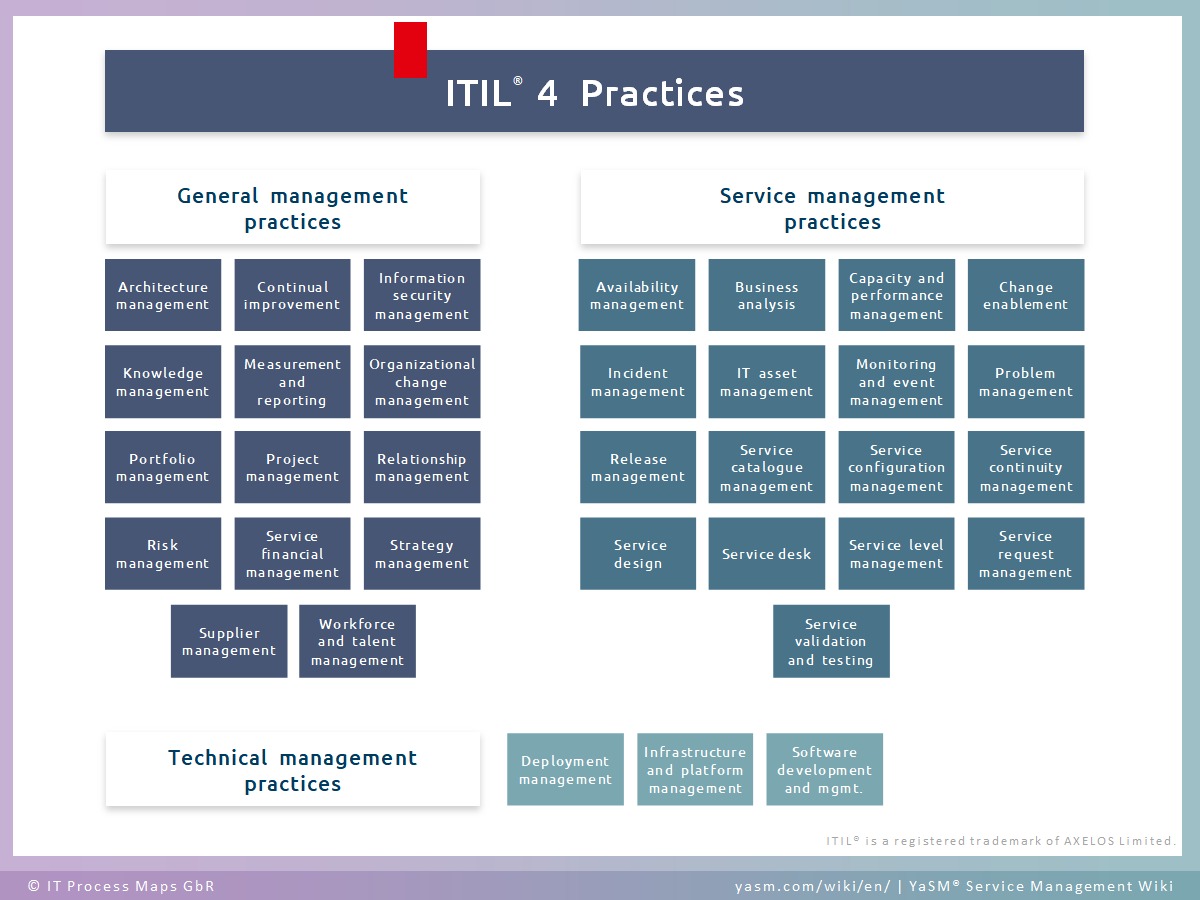
General management, service management and technical management practices.
ITIL 4 describes 34 management practices as "organizational resources designed for performing work or accomplishing an objective".
Some of these ITIL 4 practices (see fig. 3) are general management practices or methods adopted from technology management, but most of them correspond to the processes known from the previous edition of ITIL V3 and other service management frameworks.
As YaSM was designed to be aligned with ITIL, there is generally good alignment between the ITIL 4 practices and the YaSM service management processes, as described in the following tables:
- ITIL 4 general management practices and related YaSM processes
- ITIL 4 service management practices and related YaSM processes
- ITIL 4 technical management practices and related YaSM processes
The YaSM model is thus a good starting point for defining ITIL 4 processes.
Remarks:
- The management practices in this table are based on ITIL 4 Foundation, published in February 2019.
- If your organization uses ITIL V3, there is another page with a comparison between YaSM and ITIL V3 (ITIL 2011).
| ITIL 4 management practices[4] | Related YaSM processes | Comparison: YaSM service management and ITIL 4 |
|---|---|---|
| Architecture management |
|
|
| Continual improvement |
| |
| Information security management |
| |
| Knowledge management |
|
|
| Measurement and reporting |
| |
| Organizational change management |
|
|
| Portfolio management |
| |
| Project management |
| |
| Relationship management |
| |
| Risk management |
| |
| Service financial management |
| |
| Strategy management |
| |
| Supplier management |
| |
| Workforce and talent management |
|
| ITIL 4 management practices[4] | Related YaSM processes | Comparison: YaSM service management and ITIL 4 |
|---|---|---|
| Availability management |
|
|
| Business analysis |
|
|
| Capacity and performance management |
|
|
| Change enablement |
| |
| Incident management |
| |
| IT asset management |
| |
| Monitoring and event management |
| |
| Problem management |
| |
| Release management |
| |
| Service catalogue management |
| |
| Service configuration management |
| |
| Service continuity management |
| |
| Service design |
| |
| Service desk |
| |
| Service level management |
|
|
| Service request management |
| |
| Service validation and testing |
|
| ITIL 4 management practices[4] | Related YaSM processes | Comparison: YaSM service management and ITIL 4 |
|---|---|---|
| Deployment management |
|
|
| Infrastructure and platform management |
|
|
| Software development and management |
|
|
Related articles
YaSM - an alternative to ITIL®?
Once in a while I get asked during our webinars if YaSM is an alternative to ITIL. It almost seems quite a few people would like to avoid having to deal with ITIL - but is it a good idea to ignore it? [...]
Is YaSM 'ITIL lite' or 'lean ITIL'?
YaSM is definitely lighter than ITIL (actually we decided to create YaSM because many of our customers looked for something lighter). But we don't want YaSM to be confused with what is often called "ITIL lite" or "lean ITIL" because we think the existing approaches are often flawed: [...]
References
- [AXELOS, 2019]. -- AXELOS: ITIL® Foundation, ITIL 4 Edition. - The Stationery Office; Norwich, UK, February 2019.
External links
- [IT Process Wiki]. -- S. Kempter & Kempter, A.: "IT Process Wiki". -- The Wiki about the IT Infrastructure Library ITIL® (ITIL 4, ITIL 2011, ITIL V3 & V2), ISO 20000 and IT Service Management (ITSM). - IT Process Maps; Lindau (Bodensee), Germany.
- [IT Process Wiki - ITIL Processes]. -- S. Kempter: IT Process Wiki, "ITIL Processes". - IT Process Maps; Lindau (Bodensee), Germany.
Notes
[1] YaSM stands for "Yet another Service Management Model". YaSM® is a registered trademark of IT Process Maps GbR.
[2] ITIL® is a registered trademark of AXELOS Limited. - IT Infrastructure Library® is a registered trademark of AXELOS Limited. ITIL official site: axelos.com/best-practice-solutions/itil
[3] The ITIL guidance referenced in this table is based on ITIL 4 Foundation, published in February 2019.
[4] The management practices in this table are based on ITIL 4 Foundation, published in February 2019.
Is based on: The YaSM Process Map - Document: "YaSM and ITIL®"
By: Stefan Kempter ![]() and Andrea Kempter
and Andrea Kempter ![]() , IT Process Maps.
, IT Process Maps.
The YaSM model and ITIL › ITIL 4 processes and ITIL 4 process templates? › ITIL 4 components and YaSM › ITIL 4 practices and YaSM processes
